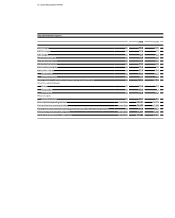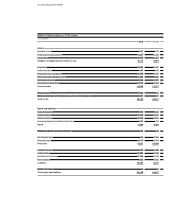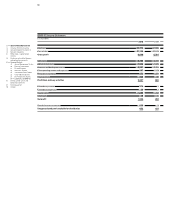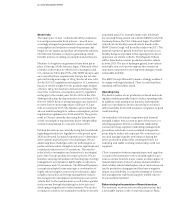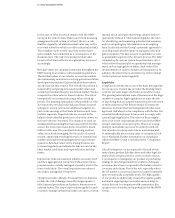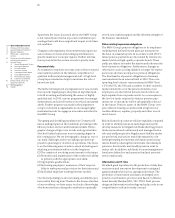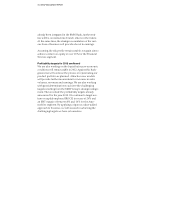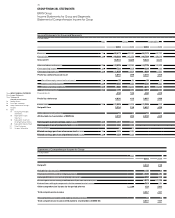BMW 2010 Annual Report Download - page 66
Download and view the complete annual report
Please find page 66 of the 2010 BMW annual report below. You can navigate through the pages in the report by either clicking on the pages listed below, or by using the keyword search tool below to find specific information within the annual report.
64
12 GROUP MANAGEMENT REPORT
12 A Review of the Financial Year
14 General Economic Environment
18 Review of Operations
41 BMW Group – Capital Market
Activities
44 Disclosures relevant for takeovers
and explanatory comments
47 Financial Analysis
47 Internal Management System
49 Earnings Performance
51 Financial Position
53 Net Assets Position
55 Subsequent Events Report
55 Value Added Statement
57 Key Performance Figures
58 Comments on BMW AG
62 Internal Control System and
explanatory comments
63 Risk Management
70 Outlook
risks. These instruments also serve as part of the process
of currency management for the purpose of taking busi-
ness decisions.
We manage currency risks both at a strategic and at an
operating level. At a strategic level (medium and long
term), foreign exchange risks are managed by “natural
hedging”, in other words by increasing the volume of
purchases denominated in foreign currency or increas-
ing
the volume of local production. In this context, the
completed expansion of the plant in Spartanburg, USA,
and the new factory in Shenyang, China (under con-
struction), will help to reduce foreign exchange risks in
two major sales markets. For operating purposes (short
and medium term), currency risks are hedged on the
financial markets. Hedging transactions are entered into
only with financial partners that have a good credit
standing. Counterparty risk management procedures are
carried out continuously to monitor creditworthiness.
The relevant procedures are set out in mandatory work
instructions.
Interest-rate risks are managed by raising refinancing
funds with matching maturities and by employing de-
rivative financial instruments. Interest-rate risks are
measured and limited both at country and Group level
on the basis of a value-at-risk approach. Limits are meas-
ured and interest-rate risks assessed on the basis of the
risk-bearing concept, combined with targets defined in
conjunction with the benchmark approach. The risk-
return ratio is also measured regularly using simulated
computations in conjunction with a present-value-based
interest rate management system. Sensitivity analyses,
which contain stress scenarios and show the potential
impact of interest-rate changes on earnings, are also used
as tools to manage interest-rate risks.
Access to liquid funds across the Group is ensured by a
broad diversification of refinancing sources. The use of
awide range of capital market instruments has proven its
worth, particularly in the midst of the difficult business
environment caused by the banking and financial crisis.
Knowledge gained from the financial crisis has been
incorporated into a so-called “target liquidity concept”.
Liquidity risk is continuously monitored at a separate
entity level. A cash flow requirements and sourcing fore-
cast system is also implemented throughout the Group
to document and manage liquidity risk. Most of the Finan-
cial
Services segment’s credit and lease business is re-
financed on the capital markets.
The BMW Group has good access to the capital markets,
thanks on the one hand to a diversified refinancing
strategy and a solid liquidity base on the other, as con-
firmed by internationally recognised rating agencies. The
Group’s good creditworthiness is reflected in the long-
standing first-class short-term ratings issued by Moody’s
(P-2) and Standard & Poor’s (A-2), a good basis for obtain-
ing
competitive refinancing conditions for short-term debt.
The outlook issued by the agencies alongside the ratings
was also lifted thanks to the recovery of sales markets
and the generally improved economic situation. In Sep-
tember 2010, Moody’s (long-term rating: A3) and
Stand-
ard & Poor’s (long-term rating: A–) both raised their
outlook from negative to stable.
During the financial year under report, we were once
again able to raise funds at good conditions. Major factors
contributing to this were our diversified refinancing
strategy, solid liquidity and strong free cash flows. If this
trend continues, the rating agencies may also raise credit-
worthiness assessments for companies in the automobile
sector.
Business performance is also influenced by conditions
prevailing on the international commodities markets. In
order to safeguard the supply of production materials
and minimise the cost risk, all relevant commodities
mar-
kets are closely monitored. Raw material prices rose
steadily as a consequence of high market liquidity and
the revival of the global economy. Over the course of
2010, we reaped the benefits of hedging contracts previ-
ously put in place. We took advantage of the favourable
market situation at the end of 2009 and beginning of
2010 to hedge the prices of precious metals (such as plat-
inum, palladium and rhodium) and of non-ferrous metals
for the current and future years using derivative instru-
ments. Changes in the price of crude oil, which is an im-
portant basic material in the manufacture of components,
have an indirect impact on our production costs. The
price of crude oil also directly influences the purchasing
behaviour of motorists when fuel prices change.
An escalation of political tensions and terrorist activi-
ties, natural catastrophes or possible pandemics could
cause raw material shortages on the one hand and, if
materials and parts fail to be delivered, could result di-
rectly
in lost production. Such factors could, however,
also impact business performance indirectly if they affect
the economy and the international capital markets.





